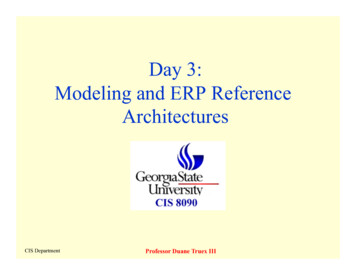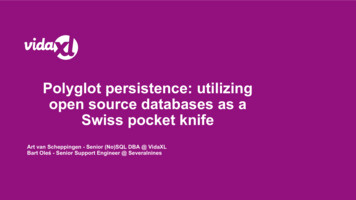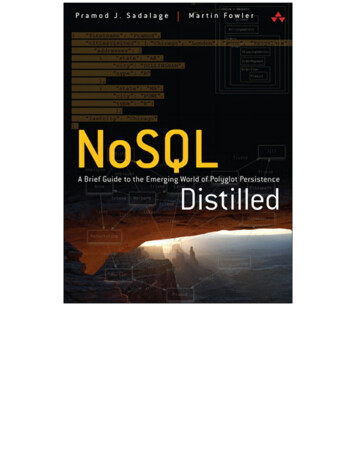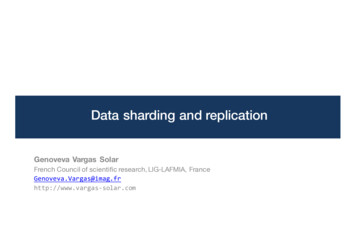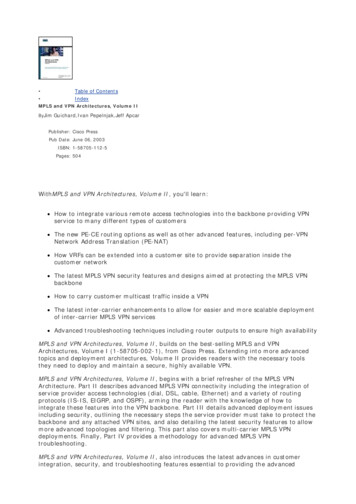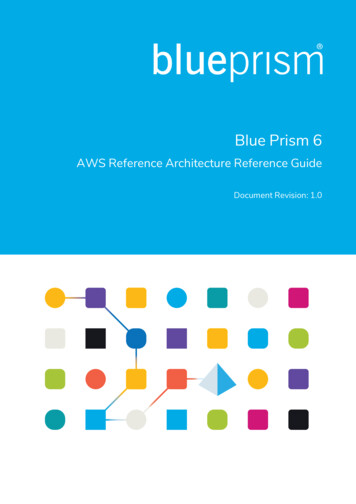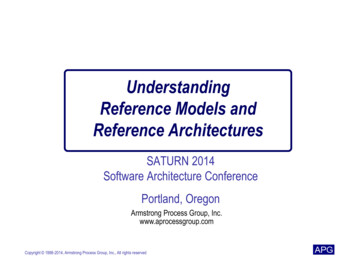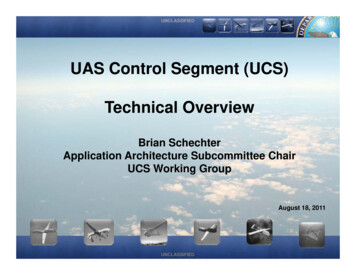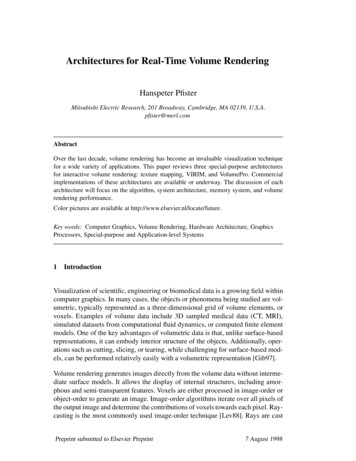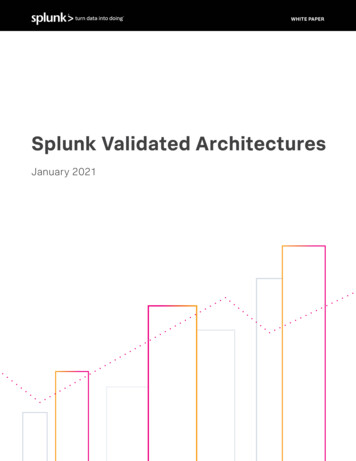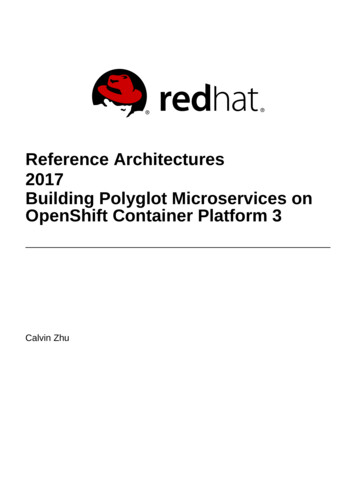
Transcription
Reference Architectures2017Building Polyglot Microservices onOpenShift Container Platform 3Calvin Zhu
Reference Architectures 2017 Building Polyglot Microservices onOpenShift Container Platform 3Calvin Zhurefarch-feedback@redhat.com
Legal NoticeCopyright 2017 Red Hat, Inc.The text of and illustrations in this document are licensed by Red Hat under a Creative CommonsAttribution–Share Alike 3.0 Unported license ("CC-BY-SA"). An explanation of CC-BY-SA isavailable athttp://creativecommons.org/licenses/by-sa/3.0/. In accordance with CC-BY-SA, if you distribute this document or an adaptation of it, you mustprovide the URL for the original version.Red Hat, as the licensor of this document, waives the right to enforce, and agrees not to assert,Section 4d of CC-BY-SA to the fullest extent permitted by applicable law.Red Hat, Red Hat Enterprise Linux, the Shadowman logo, JBoss, OpenShift, Fedora, the Infinitylogo, and RHCE are trademarks of Red Hat, Inc., registered in the United States and othercountries.Linux is the registered trademark of Linus Torvalds in the United States and other countries.Java is a registered trademark of Oracle and/or its affiliates.XFS is a trademark of Silicon Graphics International Corp. or its subsidiaries in the United Statesand/or other countries.MySQL is a registered trademark of MySQL AB in the United States, the European Union andother countries.Node.js is an official trademark of Joyent. Red Hat Software Collections is not formally related toor endorsed by the official Joyent Node.js open source or commercial project.The OpenStack Word Mark and OpenStack logo are either registered trademarks/service marksor trademarks/service marks of the OpenStack Foundation, in the United States and other countriesand are used with the OpenStack Foundation's permission. We are not affiliated with, endorsed orsponsored by the OpenStack Foundation, or the OpenStack community.All other trademarks are the property of their respective owners.AbstractThe choice of technology, programming language and supporting frameworks is often acompromise between the needs of the various parts of the application, and the skill set of thedevelopers. One advantage of the distributed nature of microservices is the ability to abandon thisone-size-fits-all approach and select the best fit for each service. This reference architecture buildsupon previous work describing microservices, and a pattern for building a microservice architectureusing Red Hat JBoss Enterprise Application Platform 7.0 on top of Red Hat OpenShift, to build apolyglot microservice environment, hosted on an on-premise OpenShift cloud. In addition to thepreviously designed MySQL and EAP services, two new services based on Ruby and Node.jsimages are included in the microservice architecture environment.
Table of ContentsTable of Contents. . . . . . . . . . . .ANDCOMMENTS. . . .FEEDBACK. . . . . . . . . . . . . . . . . . . . . . . . . . . . . . . . . . . . . . . . . . . . . . . . . . . . . . . . . . . . . . . . . . . . . . . . . . . . .3. . . . . . . . . . . . . . . . . . .1. .EXECUTIVECHAPTER. . . . . . . . . . SUMMARY. . . . . . . . . . . . . . . . . . . . . . . . . . . . . . . . . . . . . . . . . . . . . . . . . . . . . . . . . . . . . . . . . . . . . . .4. . . . . . . . . . . . . . . . . . .2. .REFERENCECHAPTER. . . . . . . . . . . ARCHITECTURE. . . . . . . . . . . . . . . ENVIRONMENT. . . . . . . . . . . . . . . . . . . . . . . . . . . . . . . . . . . . . . . . . . . . . . . . . . . . . . .5. . . . . . . . . . . . . . . . . . .3. .CREATINGCHAPTER. . . . . . . . . .THE. . . .ENVIORNMENT. . . . . . . . . . . . . . . . . . . . . . . . . . . . . . . . . . . . . . . . . . . . . . . . . . . . . . . . . . . . . . . . . . .7. . . . . . . . . .3.1. OVERVIEW3.2. BUILD AND DEPLOY3.3. RUNNING THE APPLICATION7713.CHAPTER. . . . . . . . .4. .DESIGN. . . . . . . AND. . . . .DEVELOPMENT. . . . . . . . . . . . . . . . . . . . . . . . . . . . . . . . . . . . . . . . . . . . . . . . . . . . . . . . . . . . . . . . . . . .16.4.1. OVERVIEW164.2. APPLICATION STRUCTURE164.3. CUSTOMIZING THE APPLICATION SERVER164.4. BILLING SERVICE IN RUBY184.5. BILLING SERVICE DETAILS4.6. PRODUCT SERVICE IN NODE.JS18214.7. PRODUCT SERVICE DETAILS21. . . . . . . . . .5. .CONCLUSIONCHAPTER. . . . . . . . . . . . . . . . . . . . . . . . . . . . . . . . . . . . . . . . . . . . . . . . . . . . . . . . . . . . . . . . . . . . . . . . . . . . . . . .29. . . . . . . . . . A.APPENDIX. . .REVISION. . . . . . . . .HISTORY. . . . . . . . . . . . . . . . . . . . . . . . . . . . . . . . . . . . . . . . . . . . . . . . . . . . . . . . . . . . . . . . . . . . . .30. . . . . . . . . . B.APPENDIX. . .CONTRIBUTORS. . . . . . . . . . . . . . . . . . . . . . . . . . . . . . . . . . . . . . . . . . . . . . . . . . . . . . . . . . . . . . . . . . . . . . . . . . . . . . .31. . . . . . . . . . C.APPENDIX. . .REVISION. . . . . . . . .HISTORY. . . . . . . . . . . . . . . . . . . . . . . . . . . . . . . . . . . . . . . . . . . . . . . . . . . . . . . . . . . . . . . . . . . . . .32.1
Reference Architectures 2017 Building Polyglot Microservices on OpenShift Container Platform 32
COMMENTS AND FEEDBACKCOMMENTS AND FEEDBACKIn the spirit of open source, we invite anyone to provide feedback and comments on any referencearchitecture. Although we review our papers internally, sometimes issues or typographical errors areencountered. Feedback allows us to not only improve the quality of the papers we produce, butallows the reader to provide their thoughts on potential improvements and topic expansion to thepapers. Feedback on the papers can be provided by emailing refarch-feedback@redhat.com.Please refer to the title within the email.3
Reference Architectures 2017 Building Polyglot Microservices on OpenShift Container Platform 3CHAPTER 1. EXECUTIVE SUMMARYThe choice of technology, programming language and supporting frameworks is often a compromisebetween the needs of the various parts of the application, and the skill set of the developers. Oneadvantage of the distributed nature of microservices is the ability to abandon this one-size-fits-allapproach and select the best fit for each service.This reference architecture builds upon previous work describing microservices, and a pattern forbuilding a microservice architecture using Red Hat JBoss Enterprise ApplicationPlatform 7.0 on top of Red Hat OpenShift, to build a polyglot microservice environment,hosted on an on-premise OpenShift cloud.OpenShift Container Platform 3 by Red Hat is designed for on-premise, public, or hybridcloud deployments. Built with proven open source technologies, Red Hat OpenShift is a containerplatform that helps application development and IT operations teams create and deploy apps withthe speed and consistency that business demands.This effort assumes a properly configured Red Hat OpenShift production environment and refers thereader to documents and resources to help install and configure such an environment. Themicroservice architecture project is largely imported from previous reference architecture work, withindividual services replaced with new implementations based on Ruby and Node.js.4
CHAPTER 2. REFERENCE ARCHITECTURE ENVIRONMENTCHAPTER 2. REFERENCE ARCHITECTURE ENVIRONMENTThis reference architecture designs, develops and deploys a distributed polyglot microservicearchitecture on top of Red Hat OpenShift. The application architecture is based on the design laidout and explained in depth in the reference architecture document on EAP MicroserviceArchitecture, implemented on Red Hat OpenShift in previous reference architecture work.The starting point for this project includes six services, where two of these are database servicesbased on the standard and supported MySQL image. The remaining four images in the originalreference architecture are based on the supported JBoss EAP xPaaS image and rely on the Sourceto Image (S2I) functionality to build and deploy. The EAP images are customized for two of theseservices to add a MySQL datasource.Figure 2.1. Service Diagram, only Java EE implementationThe services in the original implementation are loosely coupled, relying only on REST web servicecalls to communicate with one another. As a result, any of them can be replaced with a newimplementation, as long as the API and behavior is not changed.In this reference architecture, a new implementation is provided for two of these services, replacingthe Java EE implementation with Ruby and Node.js, respectively.The Product service is rewritten in Node.js, while the Billing service is rewritten in Ruby. No changesare required to the rest of the environment, and the new Product service will continue to talk to thesame Product MySQL database.This is the new diagram after replacing two services. The services in blue are the ones that havechanged:Figure 2.2. Service Diagram, polyglot implementation5
Reference Architectures 2017 Building Polyglot Microservices on OpenShift Container Platform 3All Red Hat OpenShift services can be configured and scaled with the desired number of replicas. Ina default Red Hat OpenShift installation, the nodes are the only targets for service deployment.However, the master hosts can also be configured as scheduleable in order to host service replicas.The presentation service is the only entry point to the application and serves HTML to the clientbrowser over HTTP. This web tier is stateless, and can therefore be replicated without concern formulticast communication or alternative EAP clustering setup. This service relies on the product,sales, and billing services, while the first two in turn rely on the MySQL product-db and sales-dbservices.6
CHAPTER 3. CREATING THE ENVIORNMENTCHAPTER 3. CREATING THE ENVIORNMENT3.1. OVERVIEWThis reference architecture may be deployed with either a single, or three master hosts. In bothcases, it is assumed that ocp-master1 refers to one (or the only) Red Hat OpenShift master host andthat the environment includes two Red Hat OpenShift node hosts with the host names of ocp-node1and ocp-node2.It is further assumed that Red Hat OpenShift has been installed by the root user and that a regularuser has been created with basic access to the host machine, as well as access to Red HatOpenShift through its identity providers.3.2. BUILD AND DEPLOY3.2.1. Creating a New ProjectLog in to a master host as the root user and create a new project, assigning the administrative rightsof the project to the previously created Red Hat OpenShift user:# oadm new-project msa \ --display-name "OpenShift 3 MSA" \ -description "This is a polyglot microservice architecture environmentbuilt on on OCP v3.4" \ --admin ocuserCreated project msa3.2.2. Red Hat OpenShift LoginOnce the project has been created, all remaining steps can be performed as the regular Red HatOpenShift user. Log in to the master host machine or switch the user, and use the oc utility toauthenticate against Red Hat OpenShift:# su - ocuser oc login -u ocuser --certificate-authority /etc/origin/master/ca.crt\ --server ntication required for https://ocpmaster1.hostname.example.com:8443 (openshift)Username: ocuserPassword: PASSWORDLogin successful.Using project "msa".Welcome! See 'oc help' to get started.The recently created msa project is the only project for this user, which is why it is automaticallyselected as the default working project of the user.3.2.3. MySQL ImagesThis reference architecture includes two database services built on the supported MySQL image.This reference architecture uses version 5.6 of the MySQL image.To deploy the database services, use the new-app command and provide a number of required and7
Reference Architectures 2017 Building Polyglot Microservices on OpenShift Container Platform 3optional environment variables along with the desired service name.To deploy the product database service: oc new-app -e MYSQL USER product -e MYSQL PASSWORD password -eMYSQL DATABASE product -e MYSQL ROOT PASSWORD passwd mysql -name product-dbTo deploy the sales database service: oc new-app -e MYSQL USER sales -e MYSQL PASSWORD password -eMYSQL DATABASE sales -e MYSQL ROOT PASSWORD passwd mysql --name salesdbWarningDatabase images created with this simple command are ephemeral and result in dataloss in the case of a pod restart. Run the image with mounted volumes to enablepersistent storage for the database. The data directory where MySQL stores databasefiles is located at /var/lib/mysql/data.NoteRefer to OpenShift Container Platform 3 by Red Hat documentation to configurepersistent storage.WarningEnabling clustering for database images is currently in Technology Preview and notintended for production use.These commands create two Red Hat OpenShift services, each running MySQL in its own container.In each case, a MySQL user is created with the value specified by the MYSQL USER attribute andthe associated password. The MYSQL DATABASE attribute results in a database being createdand set as the default user database.To monitor the provisioning of the services, use oc status. You can use oc get events for furtherinformation and troubleshooting. oc statusIn project OpenShift 3 MSA on EAP 7 (msa) on server oduct-db - 172.30.192.152:3306dc/product-db deploys openshift/mysql:5.6deployment #1 deployed 2 minutes ago - 1 pod8
CHAPTER 3. CREATING THE ENVIORNMENTsvc/sales-db - 172.30.216.251:3306dc/sales-db deploys openshift/mysql:5.6deployment #1 deployed 37 seconds ago - 1 pod2 warnings identified, use 'oc status -v' to see details.The warnings can be further inspected by using the -v flag. In this case, they simply refer to the factthat the image has no readiness probe to verify pods are ready to accept traffic or ensuredeployment is successful.Make sure the database services are successfully deployed before deploying other services thatmay depend on them. The service log clearly shows if the database has been successfullydeployed. Use tab to complete the pod name, for example: oc logs product-db-1-3drkp--- 21:21:50Processing MySQL configuration files .--- 21:21:50Initializing database .--- 21:21:50Running mysql install db .omitted.2016-06-04 21:21:58 1 [Note] /opt/rh/rhmysql56/root/usr/libexec/mysqld: ready for connections.Version: '5.6.30' socket: '/var/lib/mysql/mysql.sock' port: 3306MySQL Community Server (GPL)3.2.3.1. Creating tables for the Product serviceWhile the Sales service uses Hibernate to create the required tables in the MySQL database, theProduct service uses SQL statements to access the database, so the tables also need to bemanually created using the following SQL statements.Log into the product-db image from the MySQL client and use the following SQL statements tocreate three tables.USE product;CREATE TABLE Product (SKU BIGINT NOT NULL AUTO INCREMENT, DESCRIPTIONVARCHAR(255), HEIGHT NUMERIC(5,2) NOT NULL, LENGTH NUMERIC(5,2) NOTNULL, NAME VARCHAR(255), WEIGHTNUMERIC(5,2) NOT NULL, WIDTH NUMERIC(5,2) NOT NULL, FEATURED BOOLEANNOT NULL, AVAILABILITY INTEGER NOT NULL, IMAGE VARCHAR(255), PRICENUMERIC(7,2) NOT NULL, PRIMARY KEY (SKU)) AUTO INCREMENT 10001;CREATE TABLE Keyword (KEYWORD VARCHAR(255) NOT NULL, PRIMARY KEY(KEYWORD));CREATE TABLE PRODUCT KEYWORD (ID BIGINT NOT NULL AUTO INCREMENT,KEYWORD VARCHAR(255) NOT NULL, SKU BIGINT NOT NULL, PRIMARY KEY (ID));ALTER TABLE PRODUCT KEYWORD ADD INDEX FK PRODUCT KEYWORD PRODUCT (SKU),add constraint FK PRODUCT KEYWORD PRODUCT FOREIGN KEY (SKU) REFERENCESProduct (SKU);ALTER TABLE PRODUCT KEYWORD ADD INDEX FK PRODUCT KEYWORD KEYWORD(KEYWORD), add constraint FK PRODUCT KEYWORD KEYWORD FOREIGN KEY(KEYWORD) REFERENCES Keyword (KEYWORD);9
Reference Architectures 2017 Building Polyglot Microservices on OpenShift Container Platform 33.2.4. JBoss EAP 7 xPaaS ImagesThe Sales and Presentation services rely on Red Hat OpenShift S2I for Java EE applications anduse the Red Hat xPaaS EAP Image. You can verify the presence of this image stream in theopenshift project as the root user, but first switch from the default to the openshift project as the rootuser:# oc project openshiftNow using project "openshift" on server ry the configured image streams for the project:# oc get imagestreamsNAMEDOCKER .3 2 more.3 weeks ago.omitted.3.2.5. Ruby ImagesThe Billing service relies on Red Hat OpenShift S2I for Ruby applications and uses the Ruby image.This reference architecture uses version 2.3 of the Ruby image.3.2.6. Node.js ImagesThe Product service relies on Red Hat OpenShift S2I for Node.js applications and uses the Node.jsimage. This reference architecture uses version 4.0 of the Node.js image.3.2.7. Building the ServicesThe microservice application for this reference architecture is made available in a public gitrepository at https://github.com/RHsyseng/MSA-Polyglot-OCP. This includes four distinct services,provided as subdirectories of this repository: Billing, Product, Sales, and Presentation.Sales, and Presentation are implemented in Java and use the JBoss EAP 7 xPaaS Images. TheBilling service is implemented in Ruby, and the Product service is implemented in Node.js.Start by building and deploying the Billing service, which has no dependencies on either a databaseor another service. Switch back to the regular user with the associated msa project and run: oc new-app ruby https://github.com/RHsyseng/MSA-Polyglot-OCP.git -context-dir ruby billing --name billing-service-- Found image dc510ba (10 weeks old) in image stream "ruby" inproject "openshift" under tag "2.3" for "ruby"Ruby 2.3-------Platform for building and running Ruby 2.3 applicationsTags: builder, ruby, ruby23, rh-ruby2310
CHAPTER 3. CREATING THE ENVIORNMENT* A source build using source code it will be created* The resulting image will be pushed to image stream "billingservice:latest"* Use 'start-build' to trigger a new build* This image will be deployed in deployment config "billingservice"* Port 8080/tcp will be load balanced by service "billing-service"* Other containers can access this service through the hostname"billing-service"-- Creating resources with label app billing-service .imagestream "billing-service" createdbuildconfig "billing-service" createddeploymentconfig "billing-service" createdservice "billing-service" created-- SuccessBuild scheduled, use 'oc logs -f bc/billing-service' to track itsprogress.Run 'oc status' to view your app.Once again, oc status can be used to monitor the progress of the operation. To monitor the buildand deployment process more closely, find the running build and follow the build log: oc get SSTARTEDSourceGitRunning1 seconds ago oc logs -f bc/billing-serviceOnce this service has successfully deployed, use similar commands to deploy the Product andSales services, bearing in mind that both have a database dependency and rely on previous MySQLservices. Change any necessary default database parameters by passing them as environmentvariables.To deploy the Product service: oc new-app -e MYSQL USER product -e MYSQL PASSWORD passwordnodejs https://github.com/RHsyseng/MSA-Polyglot-OCP.git --contextdir nodejs product --name product-serviceTo deploy the Sales service. oc new-app -e MYSQL USER sales -e MYSQL PASSWORD password jbosseap70-openshift https://github.com/RHsyseng/MSA-Polyglot-OCP.git -context-dir Sales --name sales-serviceFinally, deploy the Presentation service, which exposes a web tier and an aggregator that uses thethree previously deployed services to fulfill the business request: oc new-app jboss-eap70-openshift https://github.com/RHsyseng/MSAPolyglot-OCP.git --context-dir Presentation --name presentation11
Reference Architectures 2017 Building Polyglot Microservices on OpenShift Container Platform 3Note that the Maven build file for this project specifies a war file name of ROOT, which results in thisapplication being deployed to the root context of the server.Once all four services have successfully deployed, the presentation service can be accessedthrough a browser to verify application functionality. First create a route to expose this service toclients outside the Red Hat OpenShift environment: oc expose service presentation --hostname RMINATIONpresentation msa.example.com presentation app presentationThe route tells the deployed router to load balance any requests with the given host name amongthe replicas of the presentation service. This host name should map to the IP address of the hostswhere the router has been deployed, not necessarily where the service is hosted. For clients outsideof this network and for testing purposes, simply modify your /etc/hosts file to map this host name tothe IP address of the master host.3.2.8. ReplicasDescribe the deployment configuration of your services and verify how many instances have beenconfigured and deployed. For example: oc describe dc product-serviceName: product-serviceCreated: 4 days agoLabels: app product-serviceLatest Version: 1Triggers: Config, Image(product-service@latest, auto true)Strategy: RollingTemplate:Selector: app product-service,deploymentconfig product-serviceReplicas: 1Containers:NAMEIMAGEENV.omitted.Replicas: 1 current / 1 desiredSelector: app product-service,deployment product-service1,deploymentconfig product-serviceLabels: app product-service,openshift.io/deploymentconfig.name product-servicePods Status: 1 Running / 0 Waiting / 0 Succeeded / 0 FailedNo events.Based on this default configuration, each service will not have any more than one replica, whichmeans the Red Hat OpenShift service will be backed by a single pod. In the event of the failure of aservice container or Red Hat OpenShift node, as long as there is an active master host, a new podfor the service will be deployed to a healthy node. However, it is often desirable to balance loadbetween multiple pods of a service and also avoid a lengthy downtime while a failed pod is replaced.Refer to the Red Hat OpenShift Developer Guide for deployment configuration details and properlyspecifying the number of desired replicas.To manually scale a service and verify this feature, use the oc scale command and provide thenumber of desired replicas for a given deployment configuration, for example:12
CHAPTER 3. CREATING THE ENVIORNMENT oc scale dc product-service --replicas 3deploymentconfig "product-service" scaledThere will now be 3 separate pods running this service. To verify, query all pods configured forproduct-service: oc get pods -l app mTraffic that is received through an exposed route or from an existing Red Hat OpenShift servicereferencing another service by its service / host name (as is the case with the presentation servicecalling the other services) is handled by an internal proxy and balances the load between availablereplicas, while failing over when necessary.3.3. RUNNING THE APPLICATION3.3.1. Browser AccessTo use the application, simply point your browser to the address exposed by the route. This addressshould ultimately resolve to the IP address of the Red Hat OpenShift host where the router isdeployed.Figure 3.1. Application Homepage before initializationAt this stage, the database tables are still empty and content needs to be created for the applicationto function properly.3.3.2. Sample DataThe application includes a demo page that when triggered, populates the database with sampledata. To use this page and populate the sample data, point your browser tohttp://msa.example.com/demo.jsp:Figure 3.2. Trigger sample data population13
Reference Architectures 2017 Building Polyglot Microservices on OpenShift Container Platform 33.3.3. Featured Product CatalogAfter populating the product database, the demo page redirects your browser to the route address,but this time you will see the featured products listed:Figure 3.3. Application Homepage after initialization3.3.4. User RegistrationAnonymous users are constrained to browsing inventory, viewing featured products and searchingthe catalog. To use other features that result in calls to the Sales and Billing services, a validcustomer must be logged in.To register a customer and log in, click on the Register button in the top-right corner of the screenand fill out the registration form:Figure 3.4. Customer Registration Form14
CHAPTER 3. CREATING THE ENVIORNMENTAfter registration, the purchase button allows customers to add items to their shopping cart, tosubsequently visit the shopping cart and check out, and review their order history.For details on application functionality and how each feature is implemented by the providedservices and exposes through their REST API, refer to the previously published referencearchitecture on Building microservices with JBoss EAP 7.15
Reference Architectures 2017 Building Polyglot Microservices on OpenShift Container Platform 3CHAPTER 4. DESIGN AND DEVELOPMENT4.1. OVERVIEWRed Hat OpenShift provides an ideal platform for deploying, hosting and managing microservices.By deploying each service as an individual Docker container, Red Hat OpenShift helps isolate eachservice and decouples its lifecycle and deployment from that of other services. Red Hat OpenShiftcan configure the desired number of replicas for each service and provide intelligent scaling torespond to varying load.This sample application uses the Source-to-Image (S2I) mechanism to build and assemblereproducible container images from the application source and on top of supported Red HatOpenShift images.This reference architecture builds on previously published reference architecture papers. Both theSales, and Presentation services in this reference architecture remain unchanged; please refer toBuilding microservices with JBoss EAP 7 for further details on the design and implementation ofthese two services. The Billing and Product services are replaced, with Ruby and Node.js used asthe technology to implement the two services respectively. Further information about the design andimplementation of these two services follows.4.2. APPLICATION STRUCTUREThe source code for the sample application is checked in to a public GitHub repository. Anaggregation POM file is provided at the top level of the root directory to build the two Java projects(Sales and Presentation) if needed, although this build file is neither required nor used by Red HatOpenShift.4.3. CUSTOMIZING THE APPLICATION SERVERThe Product and Sales services each have a database dependency and use their respective MySQLdatabase to store and retrieve data. For the Sales service, the supported xPaaS Middleware Imagesbundles MySQL JDBC drivers, but the driver would have to be declared in the server configurationfile and a datasource would need to be described in order for the application to access the databasethrough a connection pool.To make customizations to a server, provide an updated server configuration file. The replacementconfiguration file should be named standalone-openshift.xml and placed in a directory calledconfiguration at the root of the project.NoteSome configuration can be performed by simply providing descriptive environmentvariables. For example, supplying the DB SERVICE PREFIX MAPPING variable andvalue instructs the script to add MySQL and/or PostgreSQL datasources to the EAPinstance. Refer to the documentation for Red Hat OpenShift images for details.In order to make the required changes to the correct baseline, obtain the latest server configurationfile. The supported image is located at hift. Toview the original copy of the file, you can run this Docker container directly:16
CHAPTER 4. DESIGN AND DEVELOPMENT# docker run -it hift\ cat hift.xml ?xml version "1.0" ? server xmlns "urn:jboss:domain:4.0" extensions .Declare the datasource with parameterized variables for the database credentials. For example, toconfigure the product datasource for the product service: subsystem xmlns "urn:jboss:domain:datasources:1.2" datasources datasource jndi-name "java:jboss/datasources/ProductDS" enabled "true"use-java-context "true" pool-name "ProductDS" connection-url jdbc:mysql:// {env.DATABASE SERVICE HOST:product-db}: {env.DATABASE SERVICE PORT:3306}/ {env.MYSQL DATABASE:product} /connection-url driver mysql /driver security user-name {env.MYSQL USER:product} /user-name password {env.MYSQL PASSWORD:password} /password /security /datasource The datasource simply refers to the database driver as mysql. Declare the driver class in the samesection after the datasource: /datasource drivers driver name "mysql" module "com.mysql" xa-datasource-class com.mysql.jdbc.jdbc2.optional.MysqlXADataSource /xa-datasourceclass /driver With the above configuration, environment variables are substituted to specify connection detailsand the database host name is resolved to the name of the Red Hat OpenShift service hosting thedatabase.The default EAP welcome application is disabled in the Red Hat xPaaS EAP image. To deploy thePresentation application to the root context, rename the warName to ROOT in the Maven pom file: build finalName {project.artifactId} /finalName plugins plugin artifactId maven-war-plugin /artifactId version {version.war.plugin} /version configuration warName RO
developers. One advantage of the distributed nature of microservices is the ability to abandon this one-size-fits-all approach and select the best fit for each service. This reference architecture builds upon previous work describing microservices, and a pattern for building a microservice architecture
